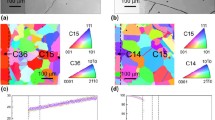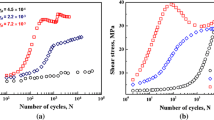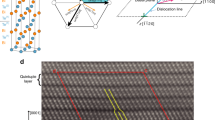Abstract
Dislocations either grown-in or produced by plastic deformation have been studied in transmission electron microscopy (TEM) in two crystals with the perovskite structure, namely BaTiO3 (P4mm at room temperature) and CaTiO3 (Pcmn). Two distinct deformation processes have been used: (i) microindentation at room temperature and (ii) creep at high temperature for BaTiO3. It is found that for both materials the easy glide systems at room temperature are {110}PC 〈1\(\bar 1\)0〉PC where the subscript PC refers to the pseudo-cubic lattices of these crystal structures. The corre-sponding Burgers vector 〈110〉PC is not the shortest lattice translation but these glide systems are such that dislocation gliding does not involve bringing the various cations close to each other. In BaTiO3, after creep at elevated temperature, the above glide systems still are observed but dislocations with Burgers vectors {100}PC are also seen. Most often they are in climb configuration i.e. their line lies in a plane {100}PC perpendicular to their Burgers vector. Furthermore they are dissociated by climb in the above plane following a reaction like [010]PC→1/2[011]+1/2[01\(\bar 1\)] the two partial Burgers vectors being orthogonal. It is suggested that this climb dissociation is due to the precipitation of the supersaturated point defects when the samples are cooled down. The equilibrium concentration of these point defects as well as their mobility would be very large at high temperature thus allowing a high temperature deformation by dislocation climb rather than by dislocation glide as it is observed at room temperature.
Similar content being viewed by others
References
Allègre CJ (1982) Chemical geodynamics. Tectonophysics 81:109–132
Ammann JJ, Buffat P, Rytz D, Stadelmann P (1984) Nature des dislocations dans KTN. Frühjahrstagung Schweiz Phys Gesell 57:474–477
Clarke R (1976) Phase transition studies of pure and flux-grown barium-titanate crystals. J Appl Cryst 9:335–338
Davies GF (1977) Whole mantle convection and plate tectonics. Geophys JR Astron Soc 49:459–486
Doukhan N (1979) TEM investigation of room temperature microplasticity in MgAl2O4 spinels. J Physique 40:L603-L606
Doukhan N, Doukhan JC, Secher D, Nicolas A (1984) Transmission electron microscope analysis of the deformation of chromites from ophiolites. Bull Mineral 107:777–793
Elsasser WM, Olson P, Marsh BD (1979) The depth of mantle convection. J Geophys Res 84:147–155
Frank FC, Nicholas JF (1953) Stable dislocations in the common crystal lattices. Philos Mag 44:1213–1235
Gaboriaud RJ, Delanot MF (1984) Etude des dislocations créées à température ambiante dans l'olivine naturelle. Bull Minéral 107:35–39
Gilman JJ (1973) Hardness, a strength microprobe. In: Westbrook JH, Conrad H (eds) The science of hardness testing and its research applications. Am Soc Metals, Metals Park (Ohio) p 51–74
Harada J, Pedersen T, Barnea J (1970) X-ray and neutron diffraction study of tetragonal barium titanate. Acta Crystallogr A 26:336–344
Hockey BJ (1973) Use of the hardness test in the study of the plastic deformation of single crystals. In: Westbrook JH, Conrad H (eds) The science of hardness testing and its research applications. Am Soc Metals, Metals Park Ohio, pp 21–50
Jeanloz R, Richter FM (1979) Convection, composition and the thermal state of the lower mantle. J Geophys Res 84:5497–5504
Kelly A, Groves GW (1970) Crystallography and crystal defects. Longman, London, pp 290–312
Liu LG (1979) Phase transformations and the constitution of the deep mantle. In: Elhinny MW (ed) The earth, its origin, structure and evolution. Academic Press, London
Malis T, Gleiter H (1976) Investigation of the structure of ferroelectric domain boundaries by transmission electron microscopy. J Appl Phys 47:5195–5200
Muller O, Roy R (1974) Crystal chemistry of non metallic materials, vol 4. The major ternary structural families. Springer, Berlin
O'Connell RJ (1977) On the scale of mantle convection. Tectonophysics 38:119–136
Poirier JP, Peyronneau J, Gesland JY, Brebec G (1983) Viscosity and conductivity of the lower mantle; an experimental study on a MgSiO3 perovskite analogue, KZnF3. Phys Eart Plan Int 32:273–287
Qi L, Jun C, Liang LB, Duan F (1983) The interactions between dislocations and ferroelectric domains in KNbO3. Radiation effects 74:307–313
Rhodes RG (1951) Barium titanate twinning at low temperature. Acta Crystallogr 4:105–110
Richter FM, McKenzie DP (1981) On some consequences and possible causes of layered mantle convection. J Geophys Res 86:6133–6144
Tanaka M, Honjo M (1964) Electron optical studies of barium titanate single crystal films. J Phys Soc Japan 19:954–970
Trepied L, Doukhan JC (1982) Transmission electron microscopy study of quartz single crystals deformed at room temperature and atmospheric pressure by indentation. J Physique 43:L77-L81
Van Duysen JC, Doukhan JC (1984) Room temperature microplasticity of α-spodumene LiAlSi2O6. Phys Chem Minerals 10:125–132
Van Duysen JC, Doukhan N, Doukhan JC (1985) Transmission electron microscope study of dislocations in orthopyroxene (Mg, Fe)2 Si2O6. Phys Chem Minerals 12:39–44
Veyssière P, Rabier J, Garem H, Grilhé J (1976) Sous-joints de dislocations et dissociations dans le ferrite de nickel déformé plastiquement à 0,85 TF. Philos Mag 33:143–163
Veyssière P, Rabier J, Garem H, Grilhé J (1978) Influence of temperature on dissociation of dislocations and plastic deformation in spinel oxides. Philos Mag 38:61–79
Westbrook JH, Conrad H (eds) (1973) The science of hardness testing and its research applications. Amer Soc Metals, Metals Park Ohio
Author information
Authors and Affiliations
Rights and permissions
About this article
Cite this article
Doukhan, N., Doukhan, J.C. Dislocations in perovskites BaTiO3 and CaTiO3 . Phys Chem Minerals 13, 403–410 (1986). https://doi.org/10.1007/BF00309185
Received:
Issue Date:
DOI: https://doi.org/10.1007/BF00309185




